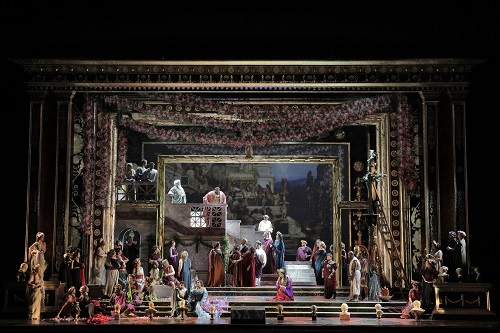 United States Mozart, La clemenza di Tito: Soloists, Chorus and Orchestra of LA Opera / James Conlon (conductor), Dorothy Chandler Pavilion, Los Angeles, 10.3.2019. (JRo)
United States Mozart, La clemenza di Tito: Soloists, Chorus and Orchestra of LA Opera / James Conlon (conductor), Dorothy Chandler Pavilion, Los Angeles, 10.3.2019. (JRo)

Production:
Director/Sets – Thaddeus Strassberger
Costumes – Mattie Ullrich
Lighting – JAX Messenger
Projections – Greg Emetaz
Chorus Preparation – Jeremy Frank
Cast:
Emperor Tito – Russell Thomas
Vitellia – Guanqun Yu
Sesto – Elizabeth DeShong
Servilia – Janai Brugger
Publio – James Creswell
Annio – Taylor Raven
Notoriously difficult to sing, La clemenza di Tito requires a stellar cast in all six roles to bring its tale of love, betrayal and forgiveness to life. LA Opera’s new production has just that: magnificent voices on stage and glorious music from the orchestra under the direction of James Conlon.
La clemenza di Tito has been performed far less than Mozart’s other operas and, when heard, it is often in concert version. LAO rectified that with a lavish production designed and directed by Thaddeus Strassberger. Like his Nabucco, seen here in 2017, Strassberger chose a romantic, opulent aesthetic to represent ancient Rome.
Though the sets and costumes were a bit heavy-handed in the manner of Technicolor sword-and-sandal epics from the 1950s and ‘60s, the dizzying glamour of the production couldn’t detract from the vocal beauty and dexterity on stage. Strassberger’s direction was sharp enough to keep this somewhat static opera lively and to reinforce the shared humanity of the characters as communicated in Mozart’s lucent score.
Nowhere was tenderness and humanity more evident than in the Act I duet for Taylor Raven’s Annio and Janai Brugger’s Servilia. Confronting their imminent separation, they sang an exquisite duet, mezzo and soprano voices melding to create an otherworldly beauty.
There was artistry everywhere. Elizabeth DeShong, in the role of the emperor’s closest friend and betrayer, Sesto, navigated the dual emotions of lust and guilt with clarity of tone, vigorous trills and flawless legato. Her ‘Parto, parto’, sung with the clarinet solo of Stuart Clark, was a standout. Guanqun Yu was the scheming Vitellia, more quietly Machiavellian in her portrayal than out-and-out evil. But when she delivered her explosive ‘Non piu di fiori’, her guilt and self-condemnation were potent. James Creswell was a vigorous Publio, anchoring the Act II trio with Vitellia and Sestos with his rich and expressive bass.
Russell Thomas as Tito colored every note with a depth and emotion worthy of an emperor. His final aria, ‘Se all’impero’, was masterful for its secure coloratura. Wearing Mattie Ullrich’s ornate costumes from golden armor to royal robes, he not only sounded royal but looked the part too.
The inspiration for costumes and sets was the late-nineteenth-century painter Lawrence Alma-Tadema, a British artist of Dutch origin, whose work is a grab bag of realism, romanticism and unapologetic kitsch. Strassberger and Ullrich employed all of these but were most successful when blending the sensibility of Alma-Tadema with a modernist approach. The Act II opening scene of Rome on fire was striking for its use of charred wood and video projections of flames. In the same act, the red train of a tormented Vitellia cascading across a steep red staircase was both elegant and startling. All the scenes were set within a gilded picture frame, which seemed more like an embellishment than a prop designed to make sense dramatically. The general palette of burgundy, gold and black was appropriately regal but somewhat predictable. It was the lighting design of JAX Messenger that made sense of the visuals and spotlighted the singers effectively: even when video projections were overused, the action remained focused.
James Conlon, one of the most gifted conductors working in opera, and the LAO Orchestra brought the tenderness, buoyancy and dignity of Mozart’s music to the fore. The afternoon spent in the company of these fine talents on stage and in the pit made it a day to remember.
Jane Rosenberg
For more about LA Opera click here.